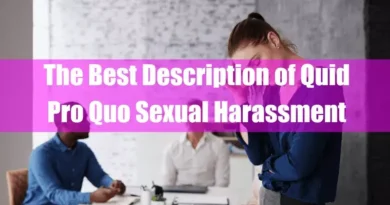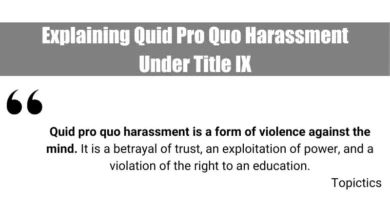I. Introduction
Schools and universities should be safe spaces for learning, but quid pro quo harassment disrupts that trust. This type of harassment involves someone in a position of power, like a teacher or coach, using their authority to pressure students for sexual favors or inappropriate conduct in exchange for good grades or special treatment.
This can be devastating for students, impacting their education and sense of safety. Educators caught in this behavior face serious consequences, including job loss, legal trouble, and professional damage.
II. What Teachers Can Do to Prevent Quid Pro Quo Harassment

Educators are pivotal in preventing quid pro quo harassment and fostering a safe and ethical learning environment. Educators can effectively safeguard students from this abuse by implementing proactive measures and maintaining professional conduct.
1. Establish clear boundaries and maintain professional conduct
Educators must establish clear boundaries and maintain professional conduct to prevent quid pro quo harassment. This includes avoiding personal conversations or interactions that could be misconstrued, maintaining appropriate physical distance, avoiding unnecessary physical contact, and refraining from making personal comments or jokes that could be considered inappropriate.
20 Quid Pro Quo Harassment Examples and How to Stop Them
2. Communicate openly and respectfully with students
Educators are pivotal in preventing quid pro quo harassment by fostering open and respectful communication with students. This involves actively listening to their concerns, promptly addressing any issues they raise, and maintaining clear expectations for student behavior and academic performance. By avoiding promises or offering rewards in exchange for favors, educators can ensure that interactions with students are based on mutual respect and professional conduct, minimizing the risk of inappropriate behavior.
How to Prove Quid Pro Quo Harassment: 13 Powerful Evidences
3. Uphold transparency in grading and assessment practices
Educators must maintain transparency in grading and assessment practices to prevent quid pro quo harassment. This involves clearly communicating grading criteria and evaluation procedures to students at the beginning of each course or training session. Grading decisions should be based solely on objective assessments and academic performance, ensuring fairness and consistency. Offering extra credit or special treatment in exchange for favors creates opportunities for exploitation. It undermines the integrity of the educational process.
Quid Pro Quo Harassment vs. Hostile Work Environment Harassment
4. Seek guidance from colleagues and administrators

Educators should proactively seek guidance from their colleagues and school administrators to prevent quid pro quo harassment. This includes discussing concerns or potential issues with trusted colleagues, seeking advice on handling delicate situations or addressing student complaints, and collaborating with school staff to establish a supportive and ethical working environment. By fostering open communication and seeking support from peers and administrators, educators can effectively address potential problems and maintain a safe and ethical learning environment for all students.
Is Quid Pro Quo Illegal? 21 Accused Celebrities Examples
5. Attend regular training on harassment prevention
Educators should regularly participate in training sessions on quid pro quo harassment to stay informed about the latest policies and procedures, enhance their understanding of harassment dynamics, and learn effective prevention strategies.
Quid Pro Quo History Examples: A Complex Dance of Mutual Exchange
6. Establish clear reporting procedures for students
Establishing clear and accessible reporting procedures is crucial to empowering students and ensuring that incidents of quid pro quo harassment are promptly addressed. Educational institutions should provide students with multiple avenues for reporting, such as designated reporting personnel, confidential online reporting platforms, and anonymous reporting mechanisms. These procedures must be easily accessible to all students, regardless of their background, identity, or personal circumstances. Upon receiving a report, educational institutions must promptly investigate the incident, ensuring confidentiality and protecting the rights of both the reporting student and the accused individual.
Explaining Quid Pro Quo Harassment Under Title IX
7. Model appropriate behavior and professionalism
Educators are pivotal in shaping their students’ ethical values and behaviors. By modeling appropriate behavior and professionalism, educators can effectively prevent quid pro quo harassment and promote a safe and ethical learning environment. This includes demonstrating respectful interactions with students, colleagues, and parents, adhering to ethical standards, upholding the integrity of the teaching profession, and setting a positive example for students that encourages ethical behavior among peers.
The 13 Legal Implications of Quid Pro Quo Harassment
8. Create a supportive and inclusive classroom environment

Cultivating a supportive and inclusive classroom environment is paramount to preventing quid pro quo harassment. By fostering a culture of respect, trust, and open communication, educators can empower students to feel comfortable discussing concerns, reporting inappropriate behavior, and seeking support when needed.
Encouraging students to speak up against inappropriate behavior sends a clear message that harassment will not be tolerated and empowers students to be active participants in creating a safe and inclusive learning environment. Additionally, promoting a sense of belonging and inclusivity for all students ensures everyone feels valued, respected, and welcomed, reducing the likelihood of power imbalances and the potential for exploitation.
How to Prevent Quid Pro Quo Harassment: 20 Effective Ways
9. Maintain clear and consistent communication with parents
Maintaining clear and consistent communication with parents is crucial in preventing quid pro quo harassment. Educators should regularly inform parents about their child’s academic progress, addressing any concerns raised promptly and respectfully. By fostering a collaborative partnership with parents, educators can work together to create a safe and supportive learning environment where students feel empowered to report any instances of inappropriate behavior.
How to Create an Anti-Harassment Policy: 9 Effective Steps
10. Seek professional support when needed
Educators should seek professional support from counselors, school psychologists, or other mental health professionals when facing challenges in managing boundaries, handling difficult situations, or dealing with stress. Additionally, seeking guidance from experienced teachers or mentors can provide valuable support in navigating ethical dilemmas and maintaining professional composure. Educators can ensure their emotional well-being and professional effectiveness by utilizing available resources to manage stress, maintain boundaries, and prevent burnout.
How to Create an Effective Anti-Harassment Policy Under Title IX.
11. Establish clear guidelines for communication outside of the classroom
To maintain professional boundaries and prevent potential misunderstandings or misinterpretations, educators should establish clear guidelines for communication outside of the classroom. This includes setting expectations for communication via email, social media, or other platforms, avoiding personal or inappropriate conversations with students outside of school hours, and maintaining professional boundaries by avoiding engaging in activities that could compromise the student-teacher relationship.
Sexual Quid Pro Quo Harassment: A Comprehensive Guide
12. Avoid favoritism or preferential treatment of individual students

Avoiding favoritism or preferential treatment of individual students is crucial in preventing quid pro quo harassment. Educators must treat all students respectfully and fairly, regardless of their personal attributes, background, or circumstances. Decisions regarding academic support, extracurricular activities, or other opportunities should be solely based on merit and performance.
Favoring or providing preferential treatment to certain students can create a perception of unfairness and could lead to accusations of quid pro quo harassment. Educators can foster a safe and equitable learning environment that promotes integrity and ethical conduct by maintaining consistent and impartial treatment for all students.
Explaining Non-Sexual Quid Pro Quo Harassment.
13. Exercise caution when using technology and social media
As educators increasingly engage with students in the digital realm, it is crucial to exercise caution when using technology and social media. To prevent inappropriate interactions, educators should establish clear guidelines for online communication, refrain from sharing personal information, and actively monitor student interactions online. Prompt intervention is essential to prevent inappropriate behavior or harassment from escalating.
Workplace Quid Pro Quo Harassment: An Ultimate Guide.
14. Document interactions and maintain records of communication
Educators should maintain meticulous records of all student interactions, including important conversations, emails, or other forms of communication. Promptly document incidents or concerns, ensuring accuracy and completeness. Store these records in a secure location and strictly adhere to confidentiality protocols.
20 Psychological Effects of Quid Pro Quo Harassment.
15. Seek clarification when unsure about boundaries or ethical dilemmas
When faced with ethical dilemmas or unclear situations, educators should seek clarification from colleagues, administrators, or school counselors to ensure compliance with ethical standards. By erring on the side of caution and avoiding actions that could be misconstrued as inappropriate, educators can uphold the highest standards of professional conduct and prevent potential misconduct.
16 Physical Effects of Quid Pro Quo Harassment.
16. Promote a culture of respect and ethical behavior within the school community
Cultivating a culture of respect and ethical behavior within the school community is paramount to preventing quid pro quo harassment. This entails encouraging open communication and reporting potential harassment incidents, fostering a climate where individuals feel safe to speak up without fear of retaliation.
Additionally, supporting initiatives that promote ethical decision-making and responsible behavior among all school community members is crucial. A culture of integrity and mutual respect can be established by emphasizing the importance of ethical conduct and providing opportunities for individuals to reflect on their ethical practices.
20 Financial Effects of Quid Pro Quo Harassment.
17. Stay informed about evolving legal and ethical standards regarding harassment

Educators must stay informed about evolving legal and ethical standards regarding harassment to prevent and address such conduct effectively. This includes regularly reviewing and updating understanding of school policies and procedures related to harassment prevention, keeping abreast of changes in state and federal laws governing harassment in educational settings, and attending workshops or webinars on emerging trends and best practices in harassment prevention.
By staying informed, educators can ensure their actions align with current legal and ethical standards, contributing to a safe and respectful learning environment for all.
Social Effects of Quid Pro Quo Harassment.
18. Encourage bystander intervention and reporting
Empowering students to become active bystanders in preventing and reporting quid pro quo harassment is crucial to fostering a safe and ethical learning environment. Educating students about their role in identifying and addressing inappropriate behavior, encouraging them to speak up and report incidents, and recognizing those who demonstrate ethical conduct in reporting harassment can effectively deter perpetrators and create a culture of collective responsibility.
23 Emotional Effects of Quid Pro Quo Harassment.
19. Promote a culture of ethical leadership among teachers
Cultivating a culture of ethical leadership among teachers is crucial for preventing quid pro quo harassment. Educational institutions can promote a culture of integrity and responsible conduct by encouraging teachers to adhere to ethical principles and serve as exemplary figures for their students. Providing opportunities for teachers to engage in self-reflection and ethical decision-making processes further strengthens their ethical compass and fosters a sense of accountability.
Additionally, fostering a collaborative environment where teachers can openly discuss ethical concerns and provide mutual support creates a robust network for addressing ethical dilemmas and upholding the highest professional standards.
13 Powerful Resources for Victims of Quid Pro Quo Harassment.
20. Seek Professional Support When Needed
Educators facing difficulties managing boundaries, handling challenging situations, or dealing with stress should seek professional support from counselors, school psychologists, or other mental health professionals. Guidance from experienced teachers, mentors, or administrators can be invaluable in navigating ethical dilemmas and maintaining professional composure.
Additionally, educators should utilize available resources to manage stress, maintain boundaries, and prevent burnout, ensuring their emotional well-being and professional effectiveness.
Victims of Quid Pro Quo Harassment: 27 People at High Risk.
III. Important Notes
A. Legal Obligations of Teachers in Reporting Suspected Quid Pro Quo Harassment
In most jurisdictions, teachers have a legal obligation to report suspected cases of quid pro quo harassment to the appropriate authorities, typically the school administration or a designated reporting officer. This obligation stems from the teacher’s role as a mandated reporter, like child protective services or healthcare professionals. Failing to report suspected harassment can result in legal repercussions, including professional sanctions or criminal charges.
26 Potential Perpetrators of Quid Pro Quo Harassment
B. Warning Signs and Red Flags of Quid Pro Quo Harassment
Educators should be on guard for warning signs of quid pro quo harassment, such as when a teacher exploits their position of authority to pressure a student into inappropriate behavior, a student offers or is pressured to provide gifts or favors in exchange for academic benefits, teachers engage in personal or flirtatious conversations with students, or attempts are made to keep interactions or relationships secret.
10 Hazardous Personal Effects of Quid Pro Quo Harassment
C. Resources for Professional Development on Quid Pro Quo Harassment
Educators can enhance their understanding of quid pro quo harassment prevention through various professional development resources, such as mandatory or recommended training sessions, online courses, webinars, and workshops by reputable organizations and educational institutions. These learning opportunities cover harassment prevention, ethical decision-making, and power dynamics in education, empowering educators to create safe and inclusive learning environments.
D. Additional Measures to Prevent Quid Pro Quo Harassment in Online Learning
To safeguard against quid pro quo harassment in online learning environments, educators should establish clear guidelines for online communication, diligently monitor online interactions, maintain professional boundaries, and promptly address any concerns students, parents, or colleagues raise.
E. Supporting Students Hesitant to Report Quid Pro Quo Harassment

To empower students hesitant to report quid pro quo harassment, educators can cultivate a supportive classroom environment, provide multiple confidential reporting avenues, assure students of protection, and offer ongoing support throughout the reporting process.
F. Cultural Considerations in Addressing Quid Pro Quo Harassment
Educators should be mindful of cultural differences when addressing quid pro quo harassment, understanding that cultural norms and perceptions of power dynamics may vary across cultures. This includes avoiding stereotypes and assumptions, seeking cultural expertise, tailoring communication and approaches, and fostering a culturally inclusive classroom environment.
G. Disciplinary Actions for Substantiated Quid Pro Quo Harassment
Educational institutions typically take disciplinary actions against educators found responsible for substantiated cases of quid pro quo harassment. The severity of disciplinary actions may vary depending on the nature of the harassment, the educator’s history, and school policies. Common disciplinary actions include verbal or written reprimands, suspension or termination of employment, loss of professional licenses or certifications, and, in severe cases, criminal charges.
H. Navigating False Accusations of Quid Pro Quo Harassment
When faced with false accusations of quid pro quo harassment, educators should maintain impartiality, gather evidence from all relevant parties, provide opportunities for explanation, seek expert advice, and make informed decisions based on a thorough investigation. Ensuring fairness and protection for all parties involved is paramount.
I. Ongoing Research and Emerging Best Practices in Quid Pro Quo Harassment Prevention
Educators should stay informed about ongoing research and emerging best practices in quid pro quo harassment prevention. This includes attending conferences and workshops, engaging with professional organizations, reviewing relevant literature, and networking with colleagues.
J. Collaboration with Law Enforcement and External Agencies
In severe cases involving potential criminal offenses or threats to safety, educators should collaborate with law enforcement or external agencies. This includes reporting suspected criminal offenses to law enforcement, consulting child protective services in child abuse or neglect cases, seeking legal advice, and informing the school administration.
K. Confidentiality and Privacy Protections
Educators have a responsibility to protect the confidentiality and privacy of individuals involved in reported cases of quid pro quo harassment. This includes limiting disclosure to authorized personnel, protecting identities, maintaining secure documentation, and providing appropriate counseling and support services.
L. Involving Students in Anti-Quid Pro Quo Harassment Policies
Educators can involve students in developing and implementing anti-quid pro quo harassment policies by seeking their input, organizing student-led discussions, and incorporating student feedback. This fosters a sense of ownership and awareness among students.
M. Addressing Power Dynamics and Harassment in Peer Relationships
Educators can address potential power dynamics and harassment within peer relationships by promoting respectful interactions, encouraging open communication, establishing clear expectations for behavior, implementing peer mediation programs, and providing counseling and support for students involved in peer harassment incidents.
N. Support Networks and Organizations for Educators
Educators can turn to various support networks and organizations for advice or assistance in handling cases of quid pro quo harassment. These include professional organizations, school counseling departments, legal counsel, and specialized training programs.
O. Promoting Bystander Intervention
Educators can promote bystander intervention by raising awareness of the concept, encouraging students to speak up and seek help, providing training on effective bystander strategies, and recognizing and rewarding positive bystander behavior.
P. Adapting Preventative Measures to Evolving Technologies
Educators should adapt preventative measures to evolving technologies and communication platforms students use. This includes providing guidance on online safety, establishing clear expectations for online interactions, monitoring online communication, and promptly addressing any concerns or reports of inappropriate behavior.
Q. Considerations for Educators in Special Education Settings
Educators in special education settings should be particularly mindful of the unique vulnerabilities of students with disabilities and take extra precautions to prevent quid pro quo harassment. This includes providing individualized support, fostering open communication with parents or guardians, and ensuring that staff receive specialized training on addressing power dynamics and harassment in special education settings.
R. Accountability Measures for Educational Institutions
Educational institutions should establish clear accountability measures to implement and enforce anti-quid pro quo harassment policies consistently. This includes regular training for all staff and students, clear reporting procedures, prompt and thorough investigations, consistent enforcement of disciplinary actions, and ongoing monitoring and evaluation of policies and practices.
IV. Conclusion
Preventing quid pro quo harassment in educational settings is paramount for ensuring a safe and conducive learning environment. By implementing the 20 effective steps outlined above, educators can proactively address power dynamics, foster open communication, and uphold professional conduct. Additionally, staying informed about legal and ethical standards, seeking support when needed, and actively involving students in anti-harassment efforts are crucial components of a comprehensive prevention strategy. Through collective efforts and a commitment to promoting respect, integrity, and inclusivity, educators can create a learning environment where quid pro quo harassment has no place, safeguarding all students’ well-being and academic progress.









